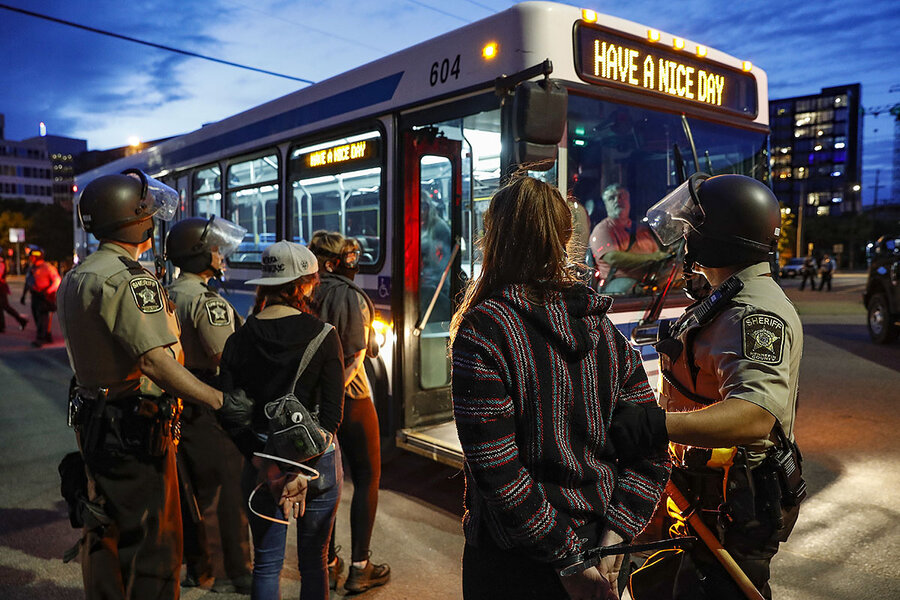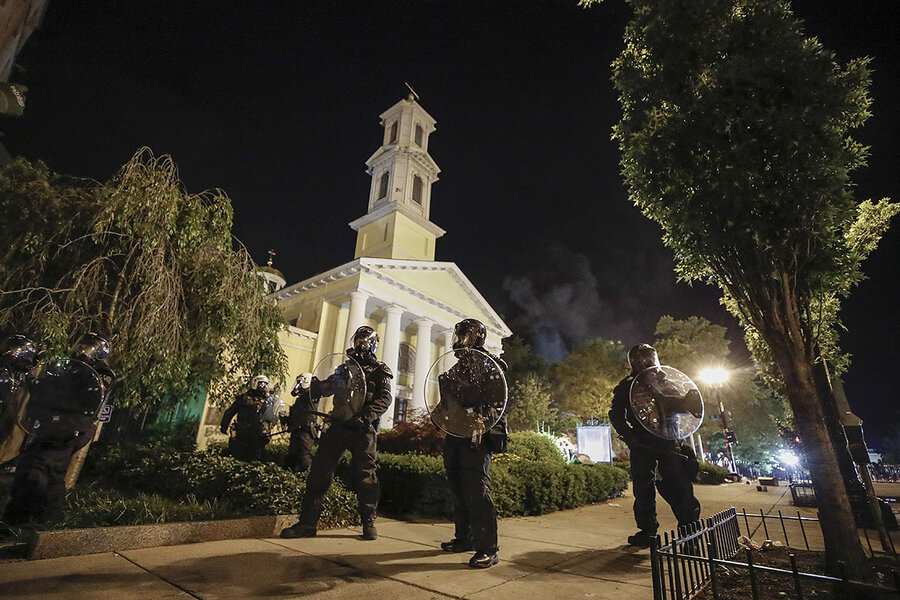COVID, race, and a pivotal moment for America
Loading...
Stressed by the calamity of the coronavirus, clashing over reopening the economy, divided by partisanship and race, America itself seems afire, as big cities reel from days of unrest sparked by the death of George Floyd in police custody last week in Minneapolis.
Videos of the violence are disturbing. National leadership appears absent. Plans for the pandemic vary by state, while the nation struggles with unprecedented unemployment. Is pressure from multiple crises causing U.S. democracy to unravel?
Why We Wrote This
Certain years loom large as icons of challenging times for America. 2020 is likely to join the roster amid a pandemic, massive protests over racially charged police killings, and deep economic stress.
Probably not, say historians. In wars and depression, America has survived intact through worse. But 2020 seems likely to become an inflection-point year studied by future students, like 1918 (deadly flu pandemic), 1929 (stock market crash), and 1968 (urban riots).
And while the nation has had pandemics, war, political violence, political polarization, rebellions, and economic depression before, only in 2020 has it had them all combined, notes Robert Vinson, a professor of history at The College of William & Mary.
As a historian, Dr. Vinson says he feels the nation fraying apart, the social contract being damaged. The next six months or so could be crucial to the country’s future.
“This is really a fork-in-the-road moment,” he says.
St. John’s Episcopal Church, across Lafayette Square from the White House, is a butter-yellow Washington icon. Many presidents have worshipped there, among them Abraham Lincoln, who would slip into the back corner of the last pew, seeking respite from the weight of his office, always sitting alone.
On Sunday night, as unrest ripped through cities across the nation, St. John’s was set ablaze.
Escorted by police, D.C. firefighters put out the blaze and initial inspections showed no significant damage. But the metaphor remains apt. Stressed by the calamity of the coronavirus, clashing over reopening the economy, divided by partisanship and racism, America itself seems afire, as big cities reel from days of unrest sparked by the death of George Floyd last week in Minneapolis.
Why We Wrote This
Certain years loom large as icons of challenging times for America. 2020 is likely to join the roster amid a pandemic, massive protests over racially charged police killings, and deep economic stress.
Videos of the violence are disturbing. National leadership appears absent. Plans for the pandemic vary by state while the nation struggles with unprecedented unemployment. Is pressure from multiple crises causing U.S. democracy to fray, even unravel?
Not literally, say some historians. In wars and depression, America has survived intact through worse. But 2020 seems likely to become an inflection-point year studied by future students, like 1918 (flu pandemic), 1929 (stock market crash), and 1968 (urban riots).
The atmosphere and events of 1968 may be the most comparable to today. Vietnam was a catastrophe building in the background. Then came sudden shocks, including the shootings of the Rev. Martin Luther King Jr. and Robert F. Kennedy. Cities exploded.
“In terms of my own experience, it feels more like 1968 in the aftermath of the MLK assassination, because of all these uprisings happening simultaneously,” says Eric Foner, professor emeritus of history at Columbia University and author of “The Second Founding: How the Civil War and Reconstruction Remade the Constitution.”
As in 1968, black Americans today are more likely to be economically disadvantaged than white people. As in 1968, many today feel the sting of racial prejudice, as evidenced by a spate of police killings of black men.
In some ways, the circumstances of 2020 are not so much a repeat of 1968’s as an extension of them, says Robert Vinson, a professor of history at The College of William & Mary.
“Structurally and systemically, there are very clear connections and similarities and continuities,” he says.
The role of leadership
Many of the protests sparked by the death of George Floyd in police custody have been peaceful processions with a multiracial mix. But many have descended into scenes of violence and looting resulting in curfews in various cities and the deployment of thousands of National Guard members in at least 15 states.
President Donald Trump and Attorney General William Barr have, without evidence, accused far-left anarchist actors known as “antifa” of orchestrating many of the protests. On Monday, in a conference call, President Trump called governors “weak” in the face of continuing violence, and urged them to “dominate” unruly protesters. If they don’t, they’re “wasting their time,” said the president.
Yet aside from tweets, President Trump himself has been mostly silent on the protests, with the exception of brief remarks on Saturday when he was in Florida to watch the launch of U.S. astronauts.
“I stand before you as a friend and ally to every American seeking justice and peace,” said the president. “Healing, not hatred, justice, not chaos, are the mission at hand.”
In some cities, police officers have been reprimanded for the kind of harsh tactics that produced the protests in the first place. In Fort Lauderdale, an officer was suspended for shoving a kneeling woman to the ground during a protest. Two Atlanta officers were fired after bashing in the window of a car and using a stun gun on occupants, according to The Associated Press.
Other police officers have tried to calm the situation by kneeling in solidarity with protesters or accompanying them on a march.
In Savannah, Georgia, for instance, a crowd of protesters surrounded a small group of officers at the city’s historic police station. The officers were clad in riot gear and tensions seemed to rise, according to Monitor correspondent Patrik Jonsson.
Then Savannah Det. Joshua Flynn began to shake hands with and hug protesters who approached him. The officers stood their ground as protesters inched closer, some yelling sharp words. But as the standoff continued, the protesters took up a different chant: “Walk with us! Walk with us!”
In this case, the police demurred. But later, officials allowed the protesters to clamber atop a National Guard truck and use its sound system to disperse the march at its end.
A history of protests
In 1968, some 110 U.S. cities suffered civil disturbances following the killing of Martin Luther King Jr. on April 4, with the largest riots in Baltimore, Washington, Kansas City, and Chicago. They followed the spate of unrest of the long hot summer of 1967, including an explosive uprising and riot in Detroit that left 43 dead and was controlled only with the help of elements of the regular Army’s 82nd and 101st Airborne Divisions.
There was another wave of violent protests in 1992, following the acquittal of police officers who had used apparently excessive force, caught on video, while arresting Rodney King.
In recent years, the Black Lives Matter movement has held protests against police brutality in many American cities. In 2015, the death of Freddie Gray in police custody in Baltimore led to violent protests following Mr. Gray’s funeral.
In that context, the current wave of protests is not at all unprecedented, says Pamela Oliver, a professor emerita of sociology at the University of Wisconsin who studies racial disparities in criminal justice.
“It’s very American. We do it a lot,” she says. “We have a lot of issues with racial violence and policing.”
This does not mean that America has made no progress on race, says Dr. Foner of Columbia University. There’s been a black president. African Americans hold political power in many cities. Police departments have made efforts to diversify and retrain their officers.
But the pace of that progress has been slow, and left some important problems untouched.
“The virus and George Floyd’s death have illustrated that not enough has changed,” says Dr. Foner.
In 1968, the underlying condition shaping the national mood was Vietnam. It was the deadliest and most expensive year of the war for the U.S. and its allies, and much of that fighting, and dying, fell to minorities.
In 2020, the underlying condition is the coronavirus, which has disproportionately affected African Americans and other minorities. With unemployment reaching record levels, the economic fallout is hitting minority communities harder too.
“There is a deep, deep sense of frustration and injustice, and it only takes an incident for that to come rolling out,” says Joe Dunn, chair of history and politics at Converse College and an expert on the protest movements of the 1960s.
A fork-in-the-road moment
America has weathered pandemics, war, political violence, political polarization, rebellions, and economic depression before 2020.
But only in 2020 has the nation faced all of them combined, says Dr. Vinson of William & Mary.
As a historian, Dr. Vinson says he feels the nation fraying apart, the social contract being damaged. The next six months or so could be crucial to the country’s future.
“This is really a fork-in-the-road moment,” he says.
The twin public health emergencies the U.S. is facing are COVID-19 and the long-standing “virus” of systemic racism, says the William & Mary professor. Fighting them will require a fundamental reconceptualization of what community means, in his view.
Looking at groups as “us” versus “them” in a time of intertwined political and health issues doesn’t work, he says.
“It’s not those folks over there in that urban center who are separate somehow from the rest of us. It’s all of us being impacted by this. And all of us have a responsibility to see it as such, because otherwise we may all go down,” says Dr. Vinson.
Staff writer Patrik Jonsson contributed to this report from Savannah, Georgia.








